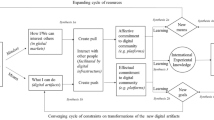Abstract
International entrepreneurship must be hard, because so few firms attempt it. If true, perhaps it is hard because it requires knowledge about people and places far away. It is hard because it requires mastering processes to handle business across borders. And it is hard because it requires trust in the processes and eventually in the customers elsewhere. These three elements, knowledge, mastery and trust in international business are essential to the success of international entrepreneurship for SMEs.
Similar content being viewed by others
References
Albert, Michael and Robin Hahnel, “A Quiet Revolution in Welfare Economics”. (http://www.zmag.org/books/2/2.htm), (April 1, 2002).
Bork, David, Dennis T. Jaffee, Sam H. Lane, Leslie Dashew, and Quentin G. Heisler, Working with Family Businesses: A Guide for Professionals. San Francisco: Jossey-Bass, 1996.
Brodie, Stewart, “Direct Sales Franchises in the UK: A Self-employment Grey Area”. International Small Business Journal 20(1), 53–74, (2002).
Caproni, Paula J., The Practical Coach: Management Skills for Everyday Life. Upper Saddle River, NJ: Prentice-Hall, 2000.
Carter, N.M., Gartner, W.B., and Reynolds, P.D., Exploring startup event sequences. Journal of Business Venturing. 11(3), 151–167, (1996).
Chrisman, James J., “The Influence of Outsider-generated Knowledge Resources on Venture Creation”, Journal of Small Business Management 37(4), 42–58, (1999).
Chandler, Gaylen N. and Steven H. Hanks “Founder Competence, the Environment, and Venture Performance”, Entrepreneurship: Theory and Practice 18(3), 77–89, (1994).
Dou, Wenyu and David C. Chou, “A Structural Analysis of Business-to-Business Digital Markets”, Industrial Marketing Management 31, 165–176, (Fall, 2001).
Ferber, Marianne A. and Jane Waldfogel, “The Long-term Consequences of Nontraditional Employment”, Monthly Labour Review 121(5), 3–12, (1998).
Franke, Ulrich J. (1999). “The Virtual Web as a New Entrepreneurial Approach to Network Organizations” Entrepreneurship and Regional Development 11(3), 203–229, (1999).
Garicano, Luis and Steven N. Kaplan, “The Effects of Business-to-Business E-Commerce on Transaction Costs”, The Journal of Industrial Economics 59, 463–485, (2001).
Garsombke, Thomas W. and Diane J. Garsombke, “Strategic Implications Facing Small Manufacturers: The Linkage Between Robotization, Computerization, Automation and Performance”, Journal of Small Business Management 27(4), 34–44, (1989).
Greene, P.G., C.G. Brush, and T. E. Brown, “Resources in Small Firms: An Exploratory Study”, Journal of Small Business Strategy 8(2), 25–40, (1997).
Hansen, E. L. “Entrepreneurial Networks and New Organization Growth”, Entrepreneurship Theory and Practice 19(4), 7–20, (1995).
Hansen, E. L., and M. S. Wortman, “Entrepreneurial Networks: The Organization in Vitro”. Paper Presented at the Academy of Management Meetings, pp. 69–73, Washington, DC, 1989.
Jaros, Stephen J., “Labour Process Theory: A Commentary on the Debate”, International Studies of Management and Organization 30, 25–39, (Winter 2000–2001).
Katz, J. A., “Distance Consulting: Potentials and Pitfalls in Using the Internet to Deliver Business Development Services to SMEs”. International Conference on Building a Modern and Effective Development Services Industry for Small Enterprises. Committee of Donor Agencies for Small Enterprise Development Coordinated by the World Bank, the Inter-American Development Bank, and the ILO. Rio de Janeiro, Brazil. http://www.ilo.org/public/english/employment/ent/papers/distcon.htm, (March 3, 1999).
Katz, J. and W. B. Gartner, “Properties of Emerging Organizations”. Academy of Management Review 13(3), 429–441, (1988).
Katz, J. A. and S. Peters, “Understanding the Entrepreneur in the Growth Process of SMEs”, The International Journal of Entrepreneurship and Innovation Management 1(3/4), 366–380, (2001).
Kaynama, Shohreh A. and Christine I. Black, “A Proposal to Assess the Service Quality of Online Travel Agencies: An Exploratory Study”, Journal of Professional Services Marketing 21(1), 63–88, (2000).
Kolvereid, L., “Prediction of Employment Status Choice Intentions”, Entrepreneurship Theory and Practice 21(1), 47–57, (1996).
Konana, Prabhudev, Nirup M. Menon, and Sridhar Balasubramanian, “The Implications of Online Investing”, Association for Computing Machinery. Communications of the ACM 43(1), 34–41, (2000).
Kuhn, Peter and Mikal Skuterud, “Job Search Methods: Internet versus Traditional”, Monthly Labour Review 123(10), 3–11, (2000).
Kundu, S. K. and J. A. Katz, “Born International SMEs: Bi-level Impacts of Resources and Intentions”, Small Business Economics 20(1), 25–47, (2003).
Lichtenstein, Benyamin M. Bergmann and Candida G. Brush, “How Do ‘Resource Bundles’ Develop and Change in New Ventures? A Dynamic Model and Longitudinal Exploration”, Entrepreneurship: Theory and Practice 25(3), 37–58, (2001).
Lucking-Reiley, David, “Auctions on the Internet: What's being Auctioned, and how?”, The Journal of Industrial Economics 48(3), 227–252, (2000).
Mayer, K. B. and S. Goldstein, “The First Two Years: Problems of Small Firm Growth and Survival”, Small Business Administration. Washington, 1961.
Mitchell, Ronald K., Brock Smith, Kristie W. Seawright and Eric A. Morse “Cross-Cultural Cognitions and the Venture Creation Decision”, Academy of Management Journal 43(5), 974–993, (2000).
Malecki, Edward J. and Ryan M. Poehling, “Extroverts and Introverts: Small Manufacturers and their Information Sources”, Entrepreneurship and Regional Development 11(3), 247–268, (1999).
Merrilees, Bill and James H. Tiessen, “Building Generalizable SME International Marketing Models Using Case Studies”, International Marketing Review 16(4/5), 326–344, (1999).
Oviatt, Benjamin M. and Patricia P. McDougall, “Toward a Theory of International New Ventures”, Journal of International Business Studies 251, 45–64, (1994).
Reynolds, Paul D., S. Michael Camp, William D. Bygrave, Erkko Autio and Michael Hay, Global Entrepreneurship Monitor 2001 Executive Report. GEM Consortium. http://www.gemconsortium.org/document.asp?id=160, (2001).
Rasheed, Howard S. and Scott W. Geiger, “Determinants of Governance Structure for the Electronic Value Chain: Resource Dependency and Transaction Costs Perspectives”, Journal of Business Strategies 18, 159–176, (2001).
Robey, Daniel, Designing Organizations. Homewood, IL: Irwin, 1986.
Sashi, C. M. and Bay O'Leary, “The Role of Internet Auctions in the Expansion of B2B Markets”, Industrial Marketing Management 31, 103–110, (2001).
Scott, W. Richard, Organizations: Rational, Natural, and Open Systems, 3rd ed. Englewood Cliffs, NJ: Prentice Hall, 1992.
Sharma, Arun, “Trends in Internet-based Business-to-Business Marketing”, Industrial Marketing Management 31, 77–84, (2002).
Williamson, Oliver E., “Economics and Organization: A Primer”, California Management Review 38 (Winter 1996), (http://proquest.umi.com/pqdweb?Did=00000...4&Deli=1amp;Idx=8&Sid=2&RQT=309), (March 4, 2002).
Author information
Authors and Affiliations
Rights and permissions
About this article
Cite this article
Katz, J.A., Safranski, S.R. & Khan, O. Virtual Instant Global Entrepreneurship. Journal of International Entrepreneurship 1, 43–57 (2003). https://doi.org/10.1023/A:1023238301590
Issue Date:
DOI: https://doi.org/10.1023/A:1023238301590




